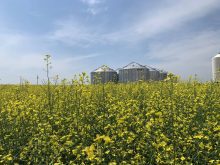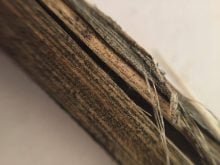No two growing seasons are alike, but Prairie canola growers can still draw from the mix of familiar and unique challenges they faced last year to better prepare for the season ahead.

“For canola, it’s about setting the crop up from the beginning, so it’s things like good trash management and weed control, and ensuring an even stand with optimal plant population,” says Erin McDougall, an Alberta-based market development agronomist for Bayer Crop Science. “An even plant stand with a good population provides a buffer and helps with making decisions about herbicide or fungicide application or swathing timing because the plants are all in a similar stage.”
Watch for herbicide-resistant weed spread
Herbicide-resistant weeds are an issue that may be top of mind for some growers in the season ahead. “Kochia has resistance to three different biotypes and that’s Group 2, 4 and 9. We saw Group 9 spreading in and through southwestern Saskatchewan a few years ago and now it’s spreading north,” says Ken Saretzky, a Saskatchewan-based market development agronomist for Bayer Crop Science.
Read Also

Claas brings 1000 Series SP forage harvesters to Canada
In mid-August, Claas unveiled its new line of Jaguar forage harvesters at an event in Visalia, California, deep in the heart of that state’s dairy region.
“In addition, Group 1- and 2-resistant wild oats have been around for a while, but we’re seeing increased spread. There are many growers who are challenged with managing these (herbicide)-resistant weeds.”
Most growers last year had few issues with pests such as bertha army worm or diamondback moth, but just because environmental conditions weren’t ideal for them last year, doesn’t mean this year will be the same. Producers can arm themselves against infestations by scouting in the spring, but also by looking at their fields’ histories over time.
Keep an eye on potential resistance issues, rotate crop protection products and canola hybrids and make field-by-field evaluations of insects and diseases.
Although producers have plenty of control options for insect pests, including some newer, enhanced seed treatments, it’s important for them not to jump the gun when an insect infestation shows up in their fields.
“Have you had severe flea beetle feeding or have cutworms been an issue in the past, and have you had to spray for them in the spring? It’s assessing all of those things and not just basing everything for next year’s crop on the year before,” says Justine Cornelsen, crop production and innovation specialist at the Canola Council of Canada.
“It’s looking at it field by field over time. Just because I’m having flea beetles in one of my canola fields doesn’t mean I need to go spray every other canola field I’ve got this year.”

The Canola Council of Canada is trying to emphasize moving from a prophylactic approach to managing pests to help maintain the effectiveness of chemical controls that are available.
“If it’s not an issue, don’t waste that product. We’ve had resistance issues building over time when we look at pest control products and similar results with the overuse of genetics — by using the same hybrids over and over (you have) the potential to build up a resistant population in the field for whatever pest you’re dealing with,” says Cornelsen.
Rotate products and genetics
Rotation, another important and fundamental tool for all crops, isn’t just about crop rotation but also rotating crop protection products like seed treatments and fungicides, as well as herbicide groups in the non-canola crops in the rotation, adds McDougall.
Cornelsen says canola growers should rotate their canola hybrids to match the changing situations in their fields.
“We have diversity in the hybrids available, so growers need to pick the correct hybrid for their field,” says Cornelsen.
As an example, growers who are making the shift to straight cutting might look at pod shatter technology and traits from several different companies to decide what will work well on their farms. If farmers are dealing with clubroot or blackleg, they can play with different genetics, and there are different seed treatment options for flea beetles.

“Growers have options to change it up and do an honest comparison on their farms of which hybrids are performing the best,” says Cornelsen. “If they are growing the same hybrid year in and year out on the entire farm, they are not going to see the potential difference they could see with growing something else. Change is a good thing.”
Evaluate need to spray for sclerotinia
Sclerotinia is always a tough disease to prepare for because it is so dependent on environmental conditions — and moisture and humidity at the right time for infection are hard to predict from year to year.
Environmental conditions across most of the Prairies last summer, with the exception of some areas of northwestern Saskatchewan, were not ideal for sclerotinia, so producers in many areas who sprayed a fungicide to manage sclerotinia last year might want to adjust their management plans for the coming season if, as looks likely, we are going through a drier cycle.
“If we have similar conditions, a fungicide application for sclerotinia might not be warranted if hot, dry summers continue,” says Cornelsen. “In the past, it was something growers often pencilled in every year because if we have humidity and moisture it was always an issue, but in a dry year, it might change their management.”
In the northwest part of Saskatchewan, a lot of growers sprayed for sclerotinia last year because they had a wet spring. And it was wet right up until flowering, so the disease was present in many cases, says Saretzky.
“One of the things growers can do in preparation for next (season) is to pencil in a petal test right at the 10 per cent flower stage,” he says. “They can get results back fairly quickly so they have time to make a decision about if it’s economical to spray based on the results, and be able to hit that narrow application time frame from 20 to 50 per cent flowering if they need to.”
That said, Saretzky knows many growers in the wetter regions of northwest Saskatchewan often pencil in a fungicide application for sclerotinia, although there are times when they can’t apply it by ground sprayer because conditions are still wet when the application window comes along. He emphasizes producers need to carefully analyze their yield monitor data in these cases to see if they should also budget for an aerial application when warranted.
“Growers can definitely tell on their yield monitors and through yield mapping the field areas that didn’t get sprayed and the areas that did and see the yield difference,” he says. “Growers put so much into their crops, we often encourage (them) to spray because if they are spending $250 to $300 per acre putting in and taking off a canola crop, and it’s another $20 for a fungicide, it’s one of those things where you want to do everything to take advantage of and get the full yield potential.”
















